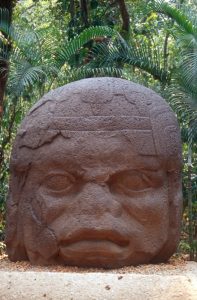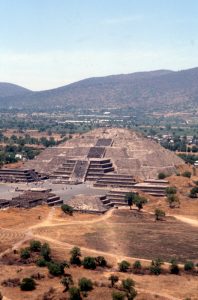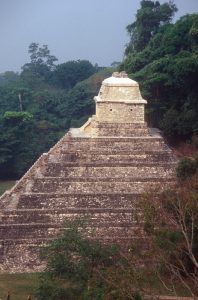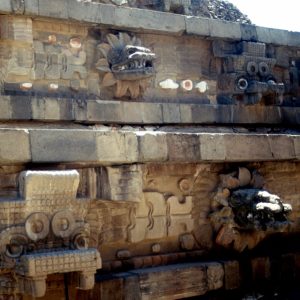Yucatan is Maya country. Not so much in the Costa May, which stretches south of Cancun and has very little to do with the largest indigenous group of people in Mexico, but more in its many discovered, and probably even more undiscovered – jungle covered – Maya archaeological sites (as you know, the word ‘ruins’ is inappropriate since we have a niece with a degree in archaeology).
What was it again, with the Olmecs, the Toltecs, the Aztecs and the Maya? All those indigenous civilizations that are collectively referred to as pre-Columbian – the last term in itself is incredible, but probably useful: subdividing the history in before and after the arrival of the ‘conquistadores’ that followed in the tracks of Christopher Columbus and his ‘discovery’ of the New World in 1492. But then, I suspect nowhere else in the world was the impact of the arrival of a couple of strangers so profound. And that all thanks to the obsession of one man!
Anyhow, long before the ‘conquistadores’, people already arrived in what is now Mexico. The first of note was the Olmec civilisation, from the Preclassic or Formative era, say 2500 BC to 250 AD. They already had a fairly complex society, and their art, architecture, religious beliefs and cultural practices are believed to be at the base of the later Mesoamerican civilizations. They are best known for their colossal heads, sculptured from basalt, with flat noses, prominent lips, and almond-shaped eyes. We have seen some of those in Villahermosa, 20 years ago.
The Olmecs were already in decline, for reasons still unknown – perhaps environmental decline, social unrest, or pressure from outside -, when Teotihuacan was established in Central Mexico, as the first truly great urban society, perhaps 100,000 people. Cosmopolitan, multi-cultural and an economic powerhouse, it dominated what is now known as the Classic period, from around 250-900 AD. The most impressive remains are the Pyramids of the Sun and the Moon, north of Mexico City (which we also admired, 20 years ago), but its architecture also influenced the Classic Maya constructions as far south as Guatemala. Unfortunately, because of the absence of written records, there is little known about its people and its rulers, neither about it sudden decline in about 650 AD – which had an dampening effect on many other cities in the region.
Further south, in Guatemala and Honduras, and in Yucatan and Southern Mexico, the Maya civilisation flourished. Its origins from perhaps 2000 BC, the Mayas reached their height also in the Classic period, through impressive city states with monumental structures, including temples, palaces, and observatories, ruled by divine kings who claimed to have descended from gods. They performed elaborate rituals, including bloodletting, human sacrifice, and ceremonial ball games, to communicate with the gods and ensure the well-being of their communities. At the same time they also advanced in areas such as architecture, mathematics, astronomy, art, and hieroglyphic writing; they established one of the few fully developed writing systems in pre-Columbian America. And yet, they, too, mysteriously declined at the end of the Classic period, except that in Yucatan, perhaps through the injection of new ideas, perhaps from invaders, they revived their culture again, and built new cities whilst old ones were abandoned. The most impressive site there, Chichen Itza, is such a later complex, whilst others, like Copan and Calakmul, all in our plans, failed. We plan to see all of those, this time around.
The decline of most of the Classic era Maya civilizations may have been due to agricultural failure, or ecological disaster; trade disruption has been suggested, because of increasing political instability, and warfare between the city states for control over territory and resources which may have led to people loosing faith in their rulers, perhaps even rebellion. Rapid population growth and urbanization, leading to pressure on resources and strains on social structures, may have led to increasing inequality, with a ruling elite losing control, resulting in social unrest and resentment among the population, which lost faith in their local leaders. Sounds familiar?
The Post-Classic period, from 900 AD until 1521, when the Spanish subjugated the Aztecs, saw initially an influx from the north, several wandering tribes invading the Mexican realm, which was weakened by its collapsing polities. The Toltecs were amongst the first to arrive, and dominated from 950-1150 AD. They were the more militaristic than earlier Mesoamerican civilizations, and also the most blood thirsty, practicing human sacrifice on a much larger scale than had been seen before. Most importantly, though, they introduced the legend of Quetzalcoatl, a feathered serpent deity.
The Aztecs, but also the remaining Maya civilisations, incorporated Quetzalcoatl in their own religion. Especially the Aztecs (also called the Mexica) revered the Toltecs, from whom they claimed direct descent, and to whom they attributed artistic, scientific and religious developments – in reality, the Toltecs copied almost everything from earlier civilizations. The Aztecs established themselves in Tenochtitlan, now Mexico City, and through alliances with neighbouring cities, flowed by a militaristic expansion policy and the introduction of an elaborate tribute system – securing their wealth – managed to create the most formidable Mexican empire.
And then Hernan Cortes landed in Mexico, burnt his ships so there was no way back, and with 550 men, a few horses, a pack of killer dogs and one canon, defeated the Aztec emperor Moctezuma. Helped by alliances with local tribes that were fed up with the Aztec dominance, but also helped by the religious belief that Quetzalcoatl – who was fair-skinned and bearded, and who had vanished to the east – was about to return, which made Moctezuma hesitate when he had the chance to eliminate the invaders.
And the rest is history. Post-Columbian history, I would say.
We’re leaving tomorrow!















